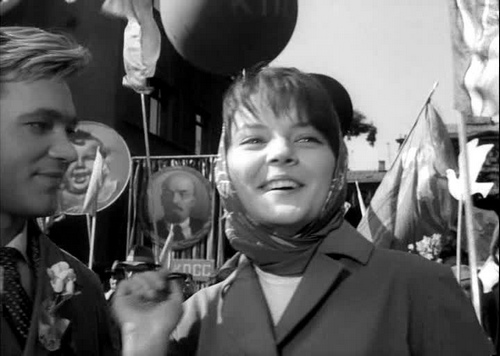
Unfortunately I couldn’t make today’s May Day parade in Moscow, but I did something even better. I re-watched the May Day parade in Mne Dvadtsat Let (1965). I don’t usually like being part of a crowd or parade, but I can’t help but enjoy this one.
It’s great fun, partly because of all the people-watching opportunities. Marlen Khutsiev filmed it at as part of an actual May Day celebration, so the crowd consists of a lot more than professional actors.
This isn’t the only place where Khutsiev used this technique of placing scenes in the context of actual public events. A couple that come to mind are a poetry reading (in the same film) and a reception for foreign ambassadors (July Rain). But this is one that makes me go, “How’d he do that?” May Day comes only once a year, so he had only one chance to get it right, but he blended the film with the actual street scenes very well. The sound track does a lot to tie things together, but the sound track couldn’t do it all by itself.
Anyhow, there is a lot to watch – the people in the crowds, and the filmmaker’s technique, as well as our hero Sergei and his new friend Anya. Sergei finally got to meet her at the celebration, after having followed her home, at a distance, after seeing her on a tramcar the previous year. (The tramcar scene is the subject of an earlier post, Twentysomething Lost in Books.)
Here are screenshots to help others join in the spirit of the celebration (I hope). Maybe even more helpful would be to watch the scene on YouTube, even though that version doesn’t have English subtitles. The parade starts at 50:20.
The celebration finally comes to an end, and later in the film Sergei and his two male friends, as well as Sergei and Anya, start to drift apart.  The issues that came between them were not entirely unlike issues that were confronting young people in the United States as the 50s turned into the 60s. The film was released in 1965 but was mostly filmed several years earlier. The delay was partly due to Khrushchev denouncing it, prompting Khutsiev to make some changes.  I’ve long wished I could see the version that Khrushchev denounced, before Khutsiev made his changes, but maybe it doesn’t exist anywhere.  This article at Kinoeye (Being 20, 40 Years Later) provides a little more detail about what happened than I’ve read elsewhere.
This film and Khutsiev’s next one, Iulskii Dozhd (July Rain) are two that sometimes make me think the world of the Soviet Union of the late 50s-early 60s is more familiar to me than the United States in the 2010s. For me they are high impact films – especially July Rain. Strangely, I’ve yet to meet anyone from Russia, either online or in person, who has seen July Rain, and I’m not sure I’ve even met anyone who even heard about it. These films did not endear Khutsiev to the Soviet authorities, so they weren’t seen by many people back at the time. And I’m not sure they would have quite the same impact on younger people, anyway. So maybe there is nobody to talk to about them.
Here’s the IMDB link for Mne Dvadtsat Let.










